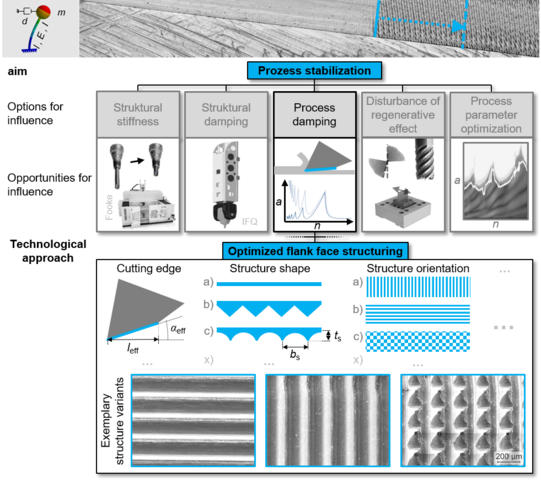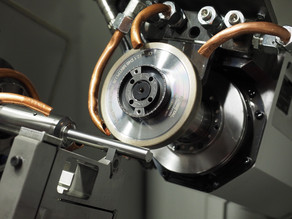Fundamental investigations on stabilizing damping effects in milling processes by using functionally structured peripheral cutting edges
Dynamic effects, such as regenerative chatter, often limit the productivity of machining processes. There are five techniques to influence process dynamics and stability: maximizing the stiffness of the production system, maximizing the structural damping of the production system, optimizing the process parameters, maximizing the process damping and disturbing the regenerative effect. Increasing the stiffness or structural damping of a production system is a major challenge in the design of machine tools and is associated with high costs. The optimal design and parameterization of a machining process and optimal use of process damping effects require a detailed knowledge of process-specific dynamic properties of the production system, other process variables and extensive expert knowledge in the field of process dynamics. The disturbance of the regenerative effect is largely independent of the framework conditions regarding the production system and process. Thus, this method is particularly interesting in terms of a universally applicable strategy for increasing productivity.
The presented project approach intends to dampen regenerative chatter vibrations during milling by using functionally structured peripheral cutting edges. These structures, which are applied on the flank face, are supposed to counteract dynamic deflections by interacting with the workpiece material and to efficiently dampen the process due to the generation of dissipative effects, e.g., as a result of increased friction. In experimental investigations the process stabilizing potential of a defined functional surface structuring was demonstrated by conducting orthogonal cuts as a suitable analogy setup with prepared cutting elements made of HSS. By using a specifically compliant tool system, the measured deflections of the tool could be used to evaluate the applied structures. The results show that the use of functionally structured flank faces significantly influences process-related damping effects, indicating a considerable potential for process stabilization. The aim of the project initiative is the application of structural design on milling tools for efficient damping of milling processes. For this purpose, suitable experimental and simulative testing environments are to be developed, which enable fundamental research on the causal relationships between structural designs and process dynamics. This is essential for the transfer of effective structural variants to milling tools. In addition to finite element analyses, the use of a geometric physically-based simulation system (GPS) for machining processes will be a central aspect. An adaptation of the process model of the GPS for the simulation of damping effects during milling is necessary, as shown by simulation experiments, in order to develop a simulation-based optimization procedure for the structural design applied on milling tools.





![[Translate to English:] [Translate to English:]](/storages/isf-mb/_processed_/6/9/csm_AG_SimPro_Eyecatcher_1920p--_5f288a9cd4.jpg)